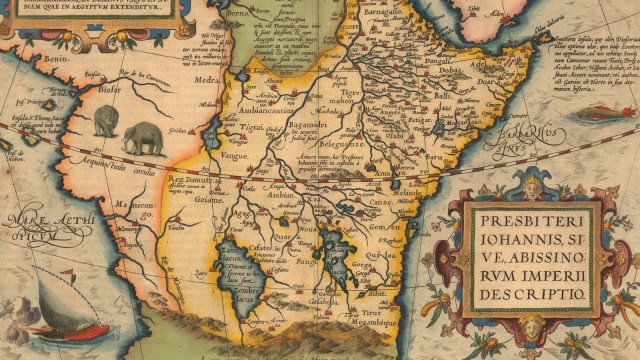447 – Old Lisbon (Not New Amsterdam)
Even old New York / Was once New Amsterdam / Why they changed it I can’t say / People just liked it better that way
– They Might Be Giants: “Istanbul (Not Constantinople)”
This map is doubly strange. It simultaneously depicts the wrong city, and under a previous name – the former error committed on purpose, the latter possibly unwittingly.
Dated 1672, this map by Frenchman Gérard Jollain purports to represent Nowel Amsterdam en Lamerique (New Amsterdam in America) – the inset top left even shows its position relative to other Dutch possessions such as Le Fort d’Orange (present-day Albany, NY) and Fort Nassau (now Gloucester City, NJ), surrounding Indian tribes like the Maquimanes, Capitanasses, Senecas and the Lacs des Iroquois peuples tres cruels (lakes of the Iroquois, very cruel people); and the neighbouring English colony of Massachusets (sic).
But the main map – one of the first bird’s eye views of a North American city – is not of New Amsterdam. This depiction of a hilly metropolis, densely packed with churches and palaces, bears no resemblance to the fledgling city then clinging to Manhattan’s southern tip. It is an almost identical copy of a popular map (1) of Lisbon, the Portuguese capital.
Was it the windmills (2) on the horizon of the original (shown at the bottom of this post) that gave Jollain the idea to transmogrify Old Lisbon into New Amsterdam? The street grid, buildings and topography are copied fairly exactly and in great detail; but however blatant the forgery is, Jollain took pains to infuse it with a Dutch atmosphere.
The ships bobbing on the Mer du Nort (Atlantic Ocean) in the foreground of the forged map are clearly of a different (and doubtlessly more appropriate) type than those on the Tagus, in front of Lisbon. Most city blocks are rendered in similar layouts, but the meticulously drawn individual houses are different.
The larger buildings are visually identical to the originals, but obviously serve a different purpose. Lisbon’s grand cathedral is New Amsterdam’s impressive Maison de Ville (City Hall). Lisbon’s Central Square becomes New Amsterdam’s Amirauté (Admiralty), the castle of São Jorge on one of Lisbon’s hilltops the Chateau de Nassau (Nassau Castle) (3).
Jollain embellishes the original with a few fantastic additions of his own. An unnamed castle on a distant Portuguese hilltop becomes the even more distant French fortress of Quebec. An empty hilltop left of the castle of São Jorge in Lisbon is occupied by a gallows in New Amsterdam, chillingly named La Iustice (Justice). A building at the foot of that hill is the location of het Tuchthuys cesta dire Maison de Dicipline, aussi en icele (?) sont renfermer des Faineans que lon fait trauailler (The prison, where lazy people are also imprisoned and made to work).
Other Dutch-sounding names sprinkeled throughout the city are Wageschot (to the left), ouestkir (Western Church [?]) and the Eglise ou Temple de Bikerque (Church or Temple of Bikerque). Further places named are Magazins des cuirs (leather warehouses), Le bureau des entrées (Customs House), Grand quay, Pelletrie (furriery), Place de la Bourse (Stock Exchange Plaza). The area to the right that is called Campus S. Clarae (St Claire’s Field) on the Lisbon map is unnamed on the New Amsterdam one, but bordered by a Hopital and a Magasin de Castors (warehouse of beaver [pelts]).
Why would a cartographer commit such a gross, and presumably easily traceable forgery? And who was this Gérard Jollain anyway? Not easily traceable himself, the rather obscure Monsieur Jollain (1641-1704) was a map seller and engraver, at some point in his career in the service of the French court, at another working in Cologne (where, one imagines, he picked up the Lisbon map). The reason for his forgery is unknown, but it is not unthinkable that he callously abused the relative ignorance of the times to present a French audience with a map of a city they had very little knowledge of. Dutch city views of New Amsterdam were in existence when Jollain produced his, but were possibly quite rare in France.
I do not know whether this forgery was a one-off, or if Jollain was in the habit of abusing his audience’s lack of access to the latest knowledge. The nomenclature of the map might illustrate how Jollain was beaten at his own game, though. He still calls the city New Amsterdam, and in the legend at the bottom of the map describes it as a Dutch colony. In fact, the city was taken over by the English in 1664 and renamed New York – eight years before he produced his remarkable forgery.
Many thanks to Francisco Feijó Delgado, who brought these maps to my attention. Quite aptly, Mr Delgado is Portuguese, and noticed that Jollain’s map of what he calls Nova Amesterdão “seemed strangely similar to our own city of Lisbon, pre-1755 [the year of the devastating earthquake].” His original entry on these maps here on his blog. Both taken from (and eminently zoomable at) the Norman B. Leventhal Map Center at the Boston Public Library (here for Old Lisbon, here for New Amsterdam).
——–
1 From the Civitates Orbis Terrarum, published by Braun & Hogenberg in Cologne in 1617.
2 Windmills, deemed iconic attributes of Dutchness (together with clogs and tulips) are quite common and typical elsewhere, also on the Iberian peninsula (Don Quixote famously fought them).
3 Please report any other concordances you might spot.







